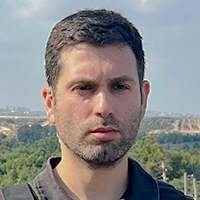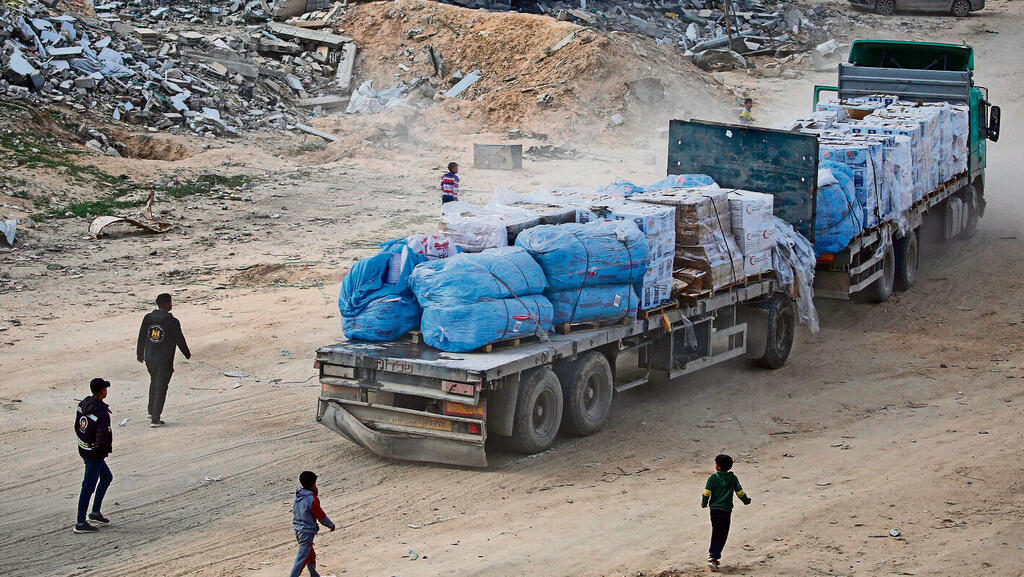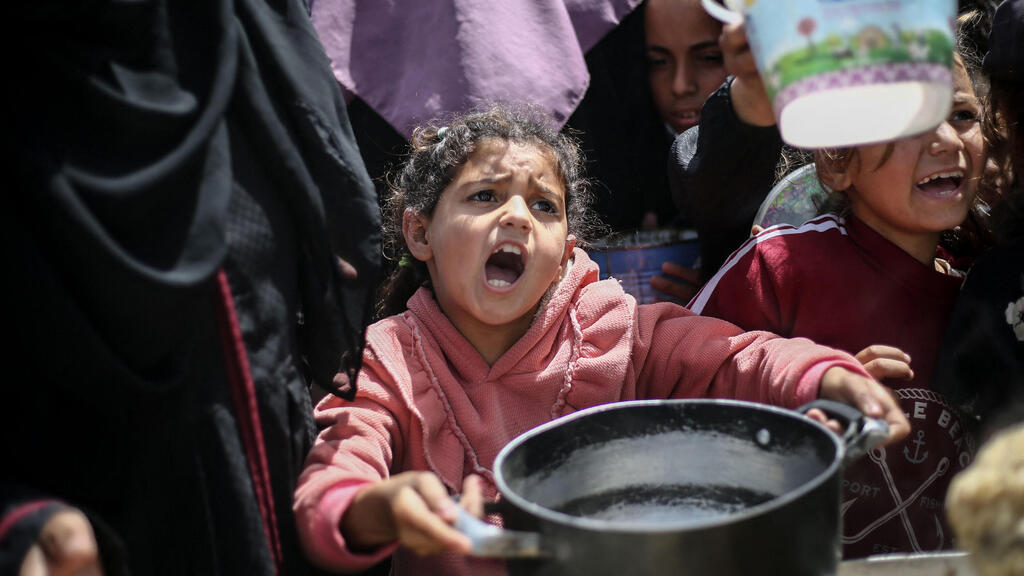Getting your Trinity Audio player ready...
Israel is expected to allow the resumption of humanitarian aid deliveries into Gaza within weeks, and in some cases even sooner, following a five-week halt in supplies, Ynet learned on Monday. The cutoff began after the collapse of the ceasefire and the suspension of negotiations for the second phase of a hostage release deal.
Over the past week, senior IDF officials and lawmakers have discussed the urgent need to resume the supply of food, fuel and medicine to avoid violations of international law that could implicate top military and political figures, particularly those in the IDF Southern Command.
Following publication of this article, the IDF spokesperson said in a statement: "In response to this morning's publication about humanitarian aid, the IDF operates according to the directives of the political echelon. Israel does not transfer and will not transfer any aid to Hamas."
During the six-week ceasefire, Israel deliberately allowed a significantly increased flow of aid into Gaza — up to 600 trucks per day, compared to 150–200 during wartime. According to military calculations, this stockpile is expected to last only a few more weeks. However, Hamas again seized much of the aid.
At the same time, Israel’s international legitimacy to conduct large-scale operations has been undermined by the March 23 killing of 14 paramedics in Rafah. According to an IDF investigation, Golani Brigade forces fired on Red Crescent ambulances in Tel al-Sultan, labeled a combat zone.
The UN Office for the Coordination of Humanitarian Affairs said the victims were buried in a mass grave, while The Guardian cited Palestinian claims that some bodies were found bound. The incident drew international scrutiny, especially following a video published by The New York Times that cast doubt on the army’s version of events.
‘The humanitarian clock is ticking’
Fuel distribution remains difficult to monitor due to its dual use. Hamas has reportedly stockpiled fuel for tunnel operations, maintaining terrorist activity and payrolls by reselling supplies across the Strip.
The IDF has intensified surveillance of Gaza’s two million residents to monitor humanitarian conditions. According to several security sources, “there’s no famine or outbreak of disease yet but Gaza is about 40–50 days away from exhausting food stocks.” Last week, Gazans reportedly looted flour warehouses previously taken over by Hamas.
4 View gallery


A photo found on the phone of one of the paramedics killed in Rafah, showing emergency signals - contrary to the IDF version
(Photo: From the New York Times)
Due to the sensitivity of the issue, the IDF now holds daily assessments. The military has identified growing difficulty among civilians in obtaining food and medicine, worsened by ongoing ground operations, particularly in Rafah. An estimated 200,000 residents have again fled their homes after the army reestablished a buffer zone between Khan Younis and Rafah.
“With the expected escalation in Rafah, the food situation will deteriorate faster in areas where fighting resumes,” IDF officials said. “The humanitarian clock is ticking — we’ll have to resume aid, even without international pressure.”
Direct distribution pilot under IDF control
Security officials noted that several major bakeries in Gaza have recently faced operational disruptions, not due to flour shortages, but gas scarcity. This is largely a result of new Israeli buffer routes that restrict access, part of a broader strategy to test future aid distribution models.
In the coming months, the IDF plans to begin a pilot program — likely in Rafah — where soldiers will oversee the direct distribution of food and medicine to civilians. This would bypass Hamas and be conducted in coordination with international aid organizations under military supervision. The goal is to diminish Hamas’ grip as Gaza’s de facto ruler and challenge its control over resources.
“Hamas is trying to promote a false narrative of famine in Gaza — we’re not there yet,” said one military source. Security officials continue to verify reports of serious shortages with local contacts inside the Strip.
The pilot may also include American private contractors, despite dissatisfaction within the IDF over a similar initiative during the ceasefire. At that time, U.S. contractors and Egyptian soldiers conducted entry screenings for Palestinians returning from southern Gaza. Senior officers said the project failed, allowing some 20,000 Hamas terrorists to reenter northern Gaza undetected. Vehicle inspections were also deemed insufficient.
Get the Ynetnews app on your smartphone: Google Play: https://bit.ly/4eJ37pE | Apple App Store: https://bit.ly/3ZL7iNv
“The fault lies not with the foreign personnel but with us — we failed to define and implement clear responsibilities,” one senior officer said. “If we work with Americans again, IDF soldiers must maintain close supervision.”
Hamas remains in control
Senior military prosecutors involved in the discussions clarified that, under international law, Gaza is not currently considered “occupied territory” in a way that would require Israel to establish full military governance. Hamas is still regarded as the ruling authority, providing basic services — albeit limited — in education, sanitation, policing and welfare.
The IDF stressed that Israel’s High Court reaffirmed this legal interpretation last week. “We’ll meet our humanitarian obligations,” the army said. “There is no siege on Gaza. Where food or medicine is lacking, we’ll allow passive entry of aid.”
IDF officials are not ruling out a pause in hostilities if the government delays ordering a broader resumption of combat. The military’s goal is no longer the total defeat of Hamas but to apply pressure to advance another phase of hostage negotiations.
4 View gallery


36th Division forces operate in the Morag Corridor in the Gaza Strip
(Photo: IDF Spokesperson's Unit)
“If we adapt to the current situation,” officials said, “we may remain stuck: Hamas still in power, hostages underground and the IDF controlling only 20–30% of the Strip, with relative calm along the border.”
“The IDF continuously monitors the humanitarian situation in Gaza and coordinates with the UN and international organizations to facilitate aid deliveries,” the IDF Spokesperson’s Unit said in a statement.
“Throughout the war, the army has allowed the entry of essential goods — such as food, water, and medical supplies — when shortages were seen. The IDF operates according to international law and targets terror groups, not civilians.”





